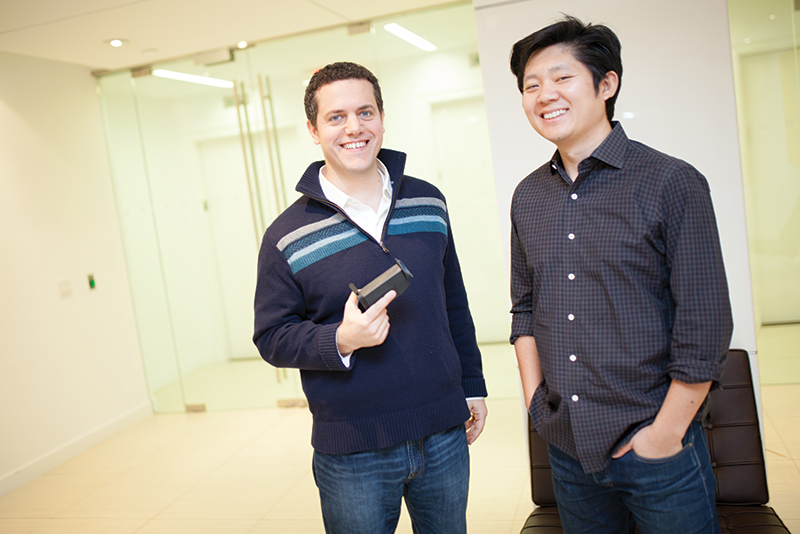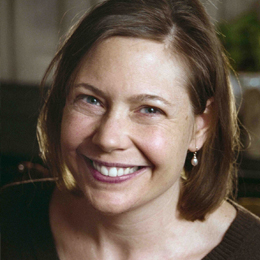Vision Quest
Two BU grads seek to revolutionize the eye exam

Imagine that you’re nearsighted. For many Americans, that’s not hard to do. Around 30 percent of people in the United States are nearsighted, and for most of them, the solution is simple: go to the eye doctor and get some glasses or contact lenses. That way, they can drive, read street signs, and recognize friends walking down the street.
For most of the world, it’s not so easy. About 90 percent of the world’s visually impaired people live in low-income settings, according to the World Health Organization (WHO). And often, there are no eye doctors or eyeglasses available. In Rwanda, for example, there are about 10.5 million people—and 14 vision specialists. Without access to an eye exam or glasses, simple nearsightedness becomes debilitating.
Now two Boston University College of Engineering graduates, Yaopeng Zhou and Marc Albanese, are trying to change those statistics. They’ve invented a handheld device called Smart Vision One (SVOne) that scans a person’s eyes, instantly determines whether he or she needs glasses, and decides what their prescription should be. Bolstered by a $1 million 2013 Powerful Answers award from Verizon, their company, Smart Vision Labs, is poised to start manufacturing and delivering SVOne devices in early 2015.
“This could be big,” says Thomas Bifano, director of BU’s Photonics Center, who advised both Zhou and Albanese on their theses at BU and now serves on their board of directors. “If this caught on, it could be so cheap that everyone has one, like a thermometer. It has the potential to be hugely disruptive.”
The device is a small block of plastic, a little larger than a deck of playing cards, which slips over an iPhone. To perform an exam, one person holds the device (technically known as a “wavefront aberrometer”) up to a patient’s eye, and presses a button. Light shines into the patient’s eye, bouncing off the retina and back out the front of the eye. Curves and imperfections in a patient’s eye will cause beams of light to bend, bouncing out of the front at slightly different angles. A sensor collects this information, the computer in the iPhone interprets it, and the result is a prescription specific to that eye. (Unless, of course, the person has perfect vision.)
Traditionally, optometrists have determined eyeglass prescriptions by asking patients to look through a phoropter, a bulky device on a swivel arm containing multiple lenses. A patient looks through lenses of different strengths and reports which ones make his or her vision the sharpest. “It’s a big, clunky, subjective measure,” says Albanese. “What we have is a small, portable device that offers you an objective number. It just gives you the answer! All you have to do is look straight.”
Albanese also says that the device could work well for young children, who are generally not known for their cooperation during eye exams.
The genesis for the device came over a decade ago, when both Zhou and Albanese were working on their graduate degrees in electrical engineering at BU’s College of Engineering. Bifano, a mechanical engineering professor, had worked for years developing “adaptive optics”—tiny, adjustable telescope mirrors that could help astronomers correct for atmospheric haze and see distant objects more distinctly. Then the technology took a twist. Bifano was invited to join a team from Schepens Eye Research Institute that was working with a grant from the National Institutes of Health (NIH) to use adaptive optics for a different application: taking better resolution photos of the mouse retina.
“All the major eye diseases affect the cells in the retina,” says Bifano. “If you have a disease like, say, diabetic retinopathy, your capillaries get clogged up, and you get little microaneurysms and new, leaky vessels forming in the retina. Seeing these in the early stage of disease would help diagnosis and treatment. But because your eye is misshapen, the physician can’t see the cellular structures in your eye. They just see a gray mishmash.”
In the summer of 2002, Bifano chose Zhou and Albanese to join the team at Schepens and help develop the technology in mice. “The eye is a window into all these health issues,” says Albanese. “Our goal was to see the blood flow in the retina, but it’s not a clear optical path.”
Eventually Zhou and Albanese wrapped up their work on the project and went their separate ways. They got jobs and then each landed separately at New York University (NYU), at different times, to work on their MBAs. In early 2012, Zhou started thinking again of his work at Schepens. He had read an article about billions of people worldwide suffering with poor vision, with no access to an optometrist. He met up with his old friend Marc Albanese at a bar in Union Square, and they discussed the problem over beers. “And Yaopeng said, ‘Why not use the same optical measurements that we used at Schepens to give people prescriptions?’” says Albanese.
In the intervening years, technology had changed to their advantage. During their work under Bifano, they had used a Dell computer costing $5,000 and a camera costing the same. “Now a $500 iPhone has basically the same camera and processing ability,” says Albanese. “You have a computer and a camera in your pocket that can do most of the work for you. It just all came together.”
The two decided to work on the project together, and formed a company. While they worked on optical problems (like finding the perfect light source and screening out unwanted reflections from the front of the eye), they also started raising money. In 2013, they won $75,000 in the NYU business plan competition. That was followed by a $100,000 grant from Founders.org, and then, in January 2014, the $1 million award from Verizon.
“That helped a lot,” says Albanese. “Yaopeng had been working on a prototype, but nothing helps a prototype like a million dollars.” The money allowed them to buy a 3D printer, hire a full-time mechanical engineer and a software engineer, and also a “director of social venture” (and director of sales) to help them bring the device to the developing world.
They now have 11 working devices—all handmade—and they will soon start production in Boston for 100 more. They are now accepting preorders for the SVOne and expect the first orders to ship out in early 2015. The device costs $3,950 with an iPhone, compared to other similar devices on the market, which cost between $15,000 and $40,000.
While their primary market is American optometrists (they made their first sale to one running a Pearle Vision center in Philadelphia), their ultimate goal is to make the device widely available in less-affluent countries. Albanese and Greg Van Kirk, the company’s director of social venture, envision a fleet of “optometrist entrepreneurs” who use the device to prescribe and sell glasses in the developing world, creating jobs and saving sight.
“I’m really excited to see this thing go,” says Bifano. “These two guys took what we taught them at BU and just ran with it. It’s been a thrill for me to see them build something from scratch. They just buckled down and made it happen.”

Comments & Discussion
Boston University moderates comments to facilitate an informed, substantive, civil conversation. Abusive, profane, self-promotional, misleading, incoherent or off-topic comments will be rejected. Moderators are staffed during regular business hours (EST) and can only accept comments written in English. Statistics or facts must include a citation or a link to the citation.